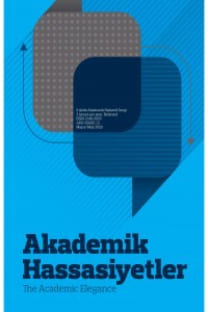POST-TRUTH: HEGEMONYA’NIN YENİ İDEOLOJİK AYGITI
Bu çalışmanın amacı, hegemonyanın kendi kültürünü, hâkimiyeti altındaki sınıflara benimsetmek amacıyla kullandığı Althusser’in Devletin İdeolojik Aygıtları’na post-modern dönemlerde ortaya çıkan post-truth olgusunu eklemlendirmektir. Zira son zamanlarda kavramın değerine ve yerine ilişkin süregelen arayışlar; söylem, kavram, olgu, çağ, zaman kesiti, durum ve atmosfer gibi tanımlamaları da beraberinde getirmiştir. Çalışma, bu arayışa farklı bir perspektiften yeni bir yön sunmayı amaçlamaktadır. Bu çalışmanın temel mahiyetini post-truth fenomeninin siyaset bilimi bağlamında anlamlandırılmasına bir katkı sağlamaktır. Mouffe’un da üzerinde durduğu gibi siyaset devinimle var olur ve değişen zamanla birlikte siyasal olanın gereği yeni araçların ortaya çıkması kaçınılmazdır. Bu minvalde çalışma öncelikle post-truth kavramının teorik çerçevesi ve onu anlamlandırmaya çalışan çeşitli yaklaşımları ele almaktadır. Ardından çalışmada hegemonya ve Devletin İdeolojik Aygıtları ile post-truth olgusu arasındaki ilişki güncel örneklerle ortaya konacaktır. Çalışmada ulaşılan temel sonuç, aktüel olarak bir takım siyasi olayların ve hegemonik güçlerin medyayı ve sosyal medyayı manipüle ederek rıza elde etmesi ve hegemonya oluşturma çabası bağlamında değerlendirilebilecek olan post truth’un bir post-dia olduğudur.
Anahtar Kelimeler:
Post-Truth, Hegemonya, Devletin İdeolojik Aygıtları
POST-TRUTH: NEW IDEOLOGICAL APPARATUS OF HEGEMONY
The aim of this study is to articulate the phenomenon of post-truth that emerged in post-modern periods to the Ideological State Apparatuses by Althusser, which hegemony uses to adopt its own culture to the classes under its rule. Then, the ongoing efforts regarding the value and place of the concept in recent times have brought along definitions such as discourse, concept, phenomenon, age, time section, situation and atmosphere. This study aims to present a new direction to these attempts with a different perspective. The main purpose of this study is to contribute to the interpretation of the post-truth phenomenon in the context of political science. As Mouffe emphasized, politics exist with motion, and new tools are inevitable to emerge as a necessity of the political one with the changing time. In this respect, this study primarily deals with the theoretical framework of the concept of post-truth and various approaches trying to interpret it. Then, the relationship between hegemony and the Ideological State Apparatuses and the phenomenon of post-truth will be revealed with recent examples. The main conclusion reached in this study is that some actual political events and hegemonic powers have acquired acquiescence by manipulating media and social media, and post-truth, which can be evaluated in the context of the effort to create hegemony, is a post-isa.
___
- Alpay, Y. (2019). Yalanın Siyaseti. İstanbul: Destek Yayınları.
- Althusser, L. (2015). İdeoloji ve Devletin İdeolojik Aygıtları. İstanbul: İthaki Yayınları.
- Atalay, H. S. (2020). Hakikatin Önemini Yitirmesi ve Gündelik Hayatın Hoyratlaşan Dili. Pasajlar Post-Truth Çağı. Yıl: 2, Sayı: 4.
- Baç, M. (2020). Hakikatin Soruşturulması, Ötelenmesi ve Geri Dönüşü Üzerine. Pasajlar Post-Truth Çağı. Yıl: 2, Sayı: 4, Ocak.
- Bryce, J. (1921). Modern Democracies. New York: Macmillan.
- Erdoğan E. ve Uyan-Semerci P. (2020). Hakikat Sonrası Tartışmaların Gerçek Olmayan Varsayımlarını Ele Almak: Akıl, Bili ve Demokrasi Karşıtlığı. Pasajlar Post-Truth Çağı. Yıl: 2, Sayı: 4, Ocak.
- Fish, W. (2016). Post-Truth Politics and Illusory Democracy. Psychotherapy and Politics International. 14(3).
- Foucault, M. (2001). Kelimeler ve Şeyler. (Çev. M. A. Kılıçbay). İstanbul: İmge Yayınları.
- Füller, S. (2018). Post-Truth: Knowledge as a Power Game. London: Anthem Press.
- Gramsci, A. (2012). Hapishane Defterleri Cilt I. (Çev. E. Ekici) İstanbul: Kalkedon Yayınları.
- Hall, S., Jacques, M. (1995). Yeni Zamanlar. (Çev. A. Yılmaz). İstanbul: Ayrıntı Yayınları.
- https://languages.oup.com/word-of-the-year/ (Erişim Tarihi: 17/03/2020).
- Karadut, İ. C. (2020). Hakikat-Ötesi Çağda Hakikati Söylemek: İki Parrhesia Vakası. Pasajlar Post-Truth Çağı. Yıl: 2, Sayı: 4, Ocak.
- Keyes, R. (2017). Hakikat Sonrası Çağ. (Çev. D. Özçetin). İzmir: Deli Dolu Yayınları.
- Köktürk, M. (2020). Post-Truth ya da Mağaraya Dönüş. Pasajlar Post-Truth Çağı. Yıl: 2, Sayı: 4, Ocak.
- McComiskey, B. (2017). Post-Truth Rhetoric and Composition. Colorado. University Press of Colorado.
- McIntyre, L. (2019). Hakikat-Sonrası. (Çev. M. F. Biçici). İstanbul: Tellekt.
- Miller, D. (1995). Blackwell’in Siyasal Düşünce Ansiklopedisi II. (Çev. B. Peker & N. Kıraç). Ankara: Ümit Yayıncılık.
- Nietzsche, F. (1968). Will to Power. (Çev. W. Kaufmann & R. J. Hollingdale). New York: Random House Inc.
- Nietzsche, F. (2011), Ahlakın Soykütüğü Üstüne. (Çev. A. İnam). İstanbul: Say Yayınları.
- Raptis, B. K. (2020). Böyle Söylerdi Nietzsche: Nihilizm, Post-Truth ve Benzerleri, Pasajlar Post-Truth Çağı, Yıl: 2, Sayı: 4, Ocak.
- Tesich, S. (1992). A Government of Lies, The Nation, January, 6/13.
- Qualter, H. T. (1980). Propaganda Teorisi ve Propagandanın Gelişimi. (Çev. Ü. Oskay). Ankara Üniversitesi SBF Dergisi.
- Williams, R. (1977). “Hegemonya Nedir? (Çev. E. Gen). (https://www.e- skop.com/skopbulten/pasajlar-hegemonya-nedir/3874, Erişim Tarihi: 18.11.2019).
- Yalçınkaya, A. (2013). Platon’un Bilişi. Sokrates’ten Jakobenlere Batı’da Siyasal Düşünceler (Ed. M. A. Ağaoğulları). İstanbul: İletişim Yayınları.
- ISSN: 2148-5933
- Yayın Aralığı: Yılda 3 Sayı
- Başlangıç: 2014
- Yayıncı: A Kitap
Sayıdaki Diğer Makaleler
POST-TRUTH: HEGEMONYA’NIN YENİ İDEOLOJİK AYGITI
MICHAEL E. PORTER VE JAY BARNEY’İN REKABET ÜSTÜNLÜĞÜ İLE İLGİLİ YAKLAŞIMLARININ DEĞERLENDİRİLMESİ
KÜRESELLEŞME BAĞLAMINDA YENİ BİR TOPLUMSAL HAREKET OLARAK İNSAN HAKLARI HAREKETİ
TÜRK DIŞ POLİTİKASINDA SÜREKLİLİK VE DEĞİŞİM: KEMALİZM VE CHP
TERÖRİZMİN DOĞASINDAKİ FARKLILIK: PKK VE IŞİD ÜZERİNE KARŞILAŞTIRMALI BİR ANALİZ
MICHAEL E. PORTER VE JAY BARNEY’ĠN REKABET ÜSTÜNLÜĞÜ ĠLE ĠLGĠLĠ YAKLAġIMLARININ DEĞERLENDĠRĠLMESĠ
